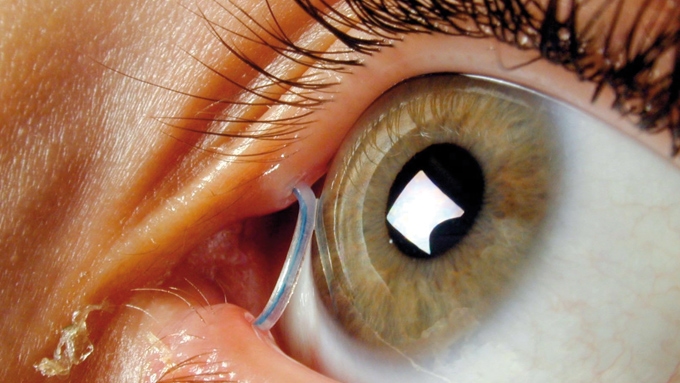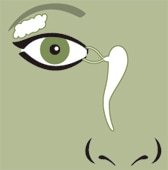
What are watery eyes?

In order for the eye to stay healthy, it is important that it is well lubricated. To do so, it has a gland that is responsible for producing lacrimal fluid. When we blink, the eyelid spreads the lacrimal fluid across the surface of the eye. Excess fluid is drawn into a small duct, eventually flowing into the nasal cavity.
Lacrimal fluid is essential to keep the eye healthy.
What causes it?
Watery eyes are caused by an excess of lacrimal fluid produced when the duct that drains the fluid into the nasal cavity is not functioning properly. This blockage causes tears to accumulate on the surface of the eye and overflow onto the cheek.
How can it be prevented?
In most cases, watery eyes cannot be prevented. When associated with a nasal infection or conjunctivitis, adequate treatment is necessary. Avoiding eye trauma helps to prevent blockage of the tear duct.
Symptoms
As well as excessive tearing, other symptoms are produced, such as excessive mucus, eye irritation and inflammation in the corner of the eye.
The lacrimal fluid that accumulates in the tear duct can sometimes become infected, causing pain and inflammation on the inner edge of the eyelids.
Associated treatments
When the tear duct is blocked, surgery can be performed to create a new lacrimal duct (dacryocystorhinostomy). In this procedure, some small silicone tubes are temporarily fitted to ensure that the new tear duct stays open until the healing process has finished.
Tear duct obstruction cannot always be repaired, however. When this occurs, it is necessary to surgically implant an artificial drainage tube.
In both cases, surgery is carried out on an outpatient basis without the need for hospitalisation. Recovery usually takes one week. Patients with tear drainage system problems are treated by oculoplastic surgeons who specialise in diseases and disorders of the eyelids, the lacrimal system, the orbit and adjacent facial structures.
Specialists who treat this pathology
FAQs
Given current lifestyles, we spend most of our time using near vision to read, work on the computer, look at our mobile phones, etc. different situations in which we “forget” to blink (we do so around half the number of times as with distant vision). As a result of less blinking, the tears are not correctly spread over the whole surface of the eye and the eye becomes dry, activating the production of small quantities of tear secretion to make up for the problem. Given that the tear’s response does not remain for long enough on the eye to correct the problem of dryness, it continues to produce tears, which end up overflowing and causing watery eyes.
The location of a blocked tear duct will determine the importance of solving the subsequent water eye problem. If the patient has a high blockage, i.e. in the lacrimal canaliculi (small ducts located on the eyelids), this is often merely a bothersome problem because of permanent watery eyes. However, when the blockage is lower and is located after the lacrimal sac, this may become infected due to the accumulation of tears and lead to dacryocystitis (inflammation of the lacrimal sac). This could eventually generate more serious problems, such as orbital cellulitis (infection of the fat and muscles around the eye).
Watery eyes may be more or less bothersome depending on each patient, but it is important to consult a specialist especially when watery eyes are associated to red eyes, pain and/or secretion. It should also be checked when a problem is no longer occasional and becomes permanent.
When the quality or the quantity of tears is not good –within a certain range– the body reacts and stimulates the secretion of tears as a protective measure. A circle is started: the eye perceives that it is dry and produces a little tear secretion, although because this is still not enough and does not solve the problem, it perceives it is dry again and produces a little more. This continues until the capacity of the tear drainage system is exceeded, leading to watery eyes.
Therefore, the use of artificial tears in patients with dry eye mostly solves the watery eye problem, as the eye is correctly lubricated and the balance is re-established.
To a greater or lesser extent, conjunctivitis is often associated with watery eyes, as the production of tears – responsible for “cleaning” the eye’s surface – increases like a defence mechanism for the body against any of the factors causing the disorder (virus, bacteria, mites, pollen, chlorine from swimming pools, etc.).
IMO Institute of Ocular Microsurgery
Josep María Lladó, 3
08035 Barcelona
Phone: (+34) 934 000 700
E-mail: international@imo.es
See map on Google Maps
By car
GPS navigator coordinates:
41º 24’ 38” N – 02º 07’ 29” E
Exit 7 of the Ronda de Dalt (mountain side). The clinic has a car park with more than 200 parking spaces.
By bus
Autobus H2: Rotonda de Bellesguard, parada 1540
Autobus 196: Josep Maria Lladó-Bellesguard, parada 3191
Autobuses H2, 123, 196: Ronda de Dalt – Bellesguard, parada 0071
How to arrive at IMO from:
IMO Madrid
C/ Valle de Pinares Llanos, 3
28035 Madrid
Phone: (+34) 910 783 783
See map in Google Maps
Public transport
Metro Lacoma (líne 7)
Autobuses:
- Lines 49 & 64, stop “Senda del Infante”
- Line N21, stop “Metro Lacoma”
Timetables
Patient care:
Monday to Friday, 8 a.m. to 9 p.m.
IMO Andorra
Av. de les Nacions Unides, 17
AD700 Escaldes-Engordany, Andorra
Phone: (+376) 688 55 44
See map in Google Maps
IMO Manresa
C/ Carrasco i Formiguera, 33 (Baixos)
08242 – Manresa
Tel: (+34) 938 749 160
See map in Google Maps
Public transport
FGC. Line R5 & R50 direction Manresa. Station/Stop: Baixador de Manresa
Timetables
Monday to Friday, 09:00 A.M – 07:00 PM







